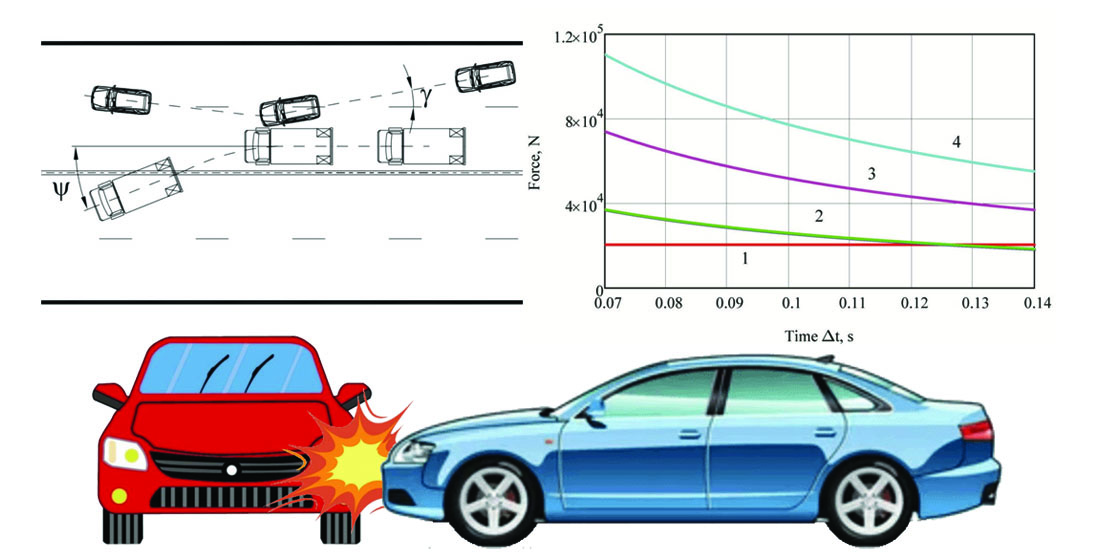Розробка математичної моделі дотичного зіткнення транспортних засобів при реконструкції обставин дорожньо-транспортної пригоди
DOI:
https://doi.org/10.15587/1729-4061.2022.267800Ключові слова:
транспортний засіб, бічний удар, втрата стійкості, відсутність гальмування, реконструкція обставин ДТПАнотація
Розглянуто проблему з’ясування обставин дорожньо-транспортної пригоди (ДТП) двох транспортних засобів внаслідок їх бічного дотичного зіткнення під невеликими кутами.
Метою дослідження є розробка математичної моделі дотичного зіткнення транспортних засобів для реконструкції обставин ДТП.
Завдяки поєднанню закону збереження імпульсу та теорії удару з використанням коефіцієнту відновлення вдалося розробити математичну модель, що описує розвиток такої ДТП та дозволяє визначити основні параметри руху транспортних засобів після та перед зіткненням. Дається відповідь щодо можливості втрати курсової стійкості транспортного засобу та його переміщення у бічному напрямі внаслідок зіткнення.
На основі математичної моделі аналітично було визначено основні параметри руху транспортних засобів після їх бічного зіткнення під кутами 5–15°, коли на дорожньому покритті не залишається слідів ковзання.
Проведено чисельний експеримент на прикладі конкретної ДТП. Результати дозволяють зробити висновок щодо можливості втрати курсової стійкості руху транспортних засобів та зміщення їх на зустрічну смугу або узбіччя внаслідок зіткнення.
Проведено порівняння результатів чисельного розрахунку з результатами програмного моделювання ДТП та обставинами, які були встановлені в процесі дослідження реального ДТП. Зроблено висновок, що отримані результати узгоджуються між собою і дають можливість більш точно оцінити параметри руху транспортних засобів після їх бічного дотичного зіткнення. В цілому це дає більш об’єктивні результати реконструкції механізму ДТП у випадках, коли відсутні сліди ковзання та гальмування на дорожньому покритті.
Запропонована математична модель може використовуватися при зіткненнях, що супроводжуються незначними деформаціями або пошкодженнями транспортних засобів
Посилання
- Ilarionov, V. A. (1989). Ekspertiza dorozhno-transportnykh proisshestviy. Moscow: Transport, 256.
- Evtyukov, S. A., Vasil'ev, Ya. V. (2006). Ekspertiza dorozhno-transportnykh proisshestviy. Sankt-Peterburg: Izd-vo DNK, 536.
- Gidlewski, M., Prochowski, L., Jemioł, L., Żardecki, D. (2018). The process of front-to-side collision of motor vehicles in terms of energy balance. Nonlinear Dynamics, 97 (3), 1877–1893. doi: https://doi.org/10.1007/s11071-018-4688-x
- Wei, T., Zhi-qiang, L., Ai-hong, Z., Liang, J. (2018). A simplified model for analysis of Side-impact Velocity Based on Energy Method. IOP Conference Series: Materials Science and Engineering, 392, 062126. doi: https://doi.org/10.1088/1757-899x/392/6/062126
- Viba, J., Liberts, G., Gonca, V. (2009). Car Rollover Collision With Pit Corner. Transport, 24 (1), 76–82. doi: https://doi.org/10.3846/1648-4142.2009.24.76-82
- Turenko, A. M., Klymenko, V. I., Saraiev, O. V., Danets, S. V. (2013). Avtotekhnichna ekspertyza. Doslidzhennia obstavyn DTP. Kharkiv: KhNADU, 320.
- Rodionov, Yu. V., Novopisniy, E. A. (2015). Metodiki ekspertnogo issledovaniya stolknoveniy transportnykh sredstv. Penza: PGUAS, 188.
- Wach, W. (2020). Spatial Impulse-Momentum Collision Model in Programs for Simulation of Vehicle Accidents. 2020 XII International Science-Technical Conference AUTOMOTIVE SAFETY. doi: https://doi.org/10.1109/automotivesafety47494.2020.9293494
- Vangi, D., Begani, F., Spitzhüttl, F., Gulino, M.-S. (2019). Vehicle accident reconstruction by a reduced order impact model. Forensic Science International, 298, 426.e1–426.e11. doi: https://doi.org/10.1016/j.forsciint.2019.02.042
- Chen, Q., Xie, Y., Ao, Y., Li, T., Chen, G., Ren, S. et al. (2021). A deep neural network inverse solution to recover pre-crash impact data of car collisions. Transportation Research Part C: Emerging Technologies, 126, 103009. doi: https://doi.org/10.1016/j.trc.2021.103009
- Strother, C. E., Woolley, R. L., James, M. B., Warner, C. Y. (1986). Crush Energy in Accident Reconstruction. SAE Technical Paper Series. doi: https://doi.org/10.4271/860371
- Wach, W., Gidlewski, M., Prochowski, L. (2016). Modelling reliability of vehicle collision reconstruction based on the law of conservation of momentum and Burg equations. Proceedings of 20th International Scientific Conference. Transport Means 2016, Part II. Kaunas University of Technology Publisher, Kaunas 2016, 693–698. Available at: https://www.researchgate.net/publication/321071413_Modelling_Reliability_of_Vehicle_Collision_Reconstruction_Based_on_the_Law_of_Conservation_of_Momentum_and_Burg_Equations
- Dong, H.-C., Nie, Z.-G. (2017). Identification for Speed of Vehicle and Its Uncertainty Analysis of Road Traffic Accident by Momentum Method. DEStech Transactions on Computer Science and Engineering. doi: https://doi.org/10.12783/dtcse/csma2017/17373
- Povaliaiev, S., Saraiev, O. (2021). Mathematical model for estimation the stability of the vehicle’s motion on overturning. Vehicle and Electronics. Innovative Technologies, 19, 47–52. doi: https://doi.org/10.30977/veit.2021.19.0.47
- Li, B., Bei, S. (2019). Research method of vehicle rollover mechanism under critical instability condition. Advances in Mechanical Engineering, 11 (1), 168781401882121. doi: https://doi.org/10.1177/1687814018821218
- Imine, H., Benallegue, A., Madani, T., Srairi, S. (2014). Rollover Risk Prediction of Heavy Vehicle Using High-Order Sliding-Mode Observer: Experimental Results. IEEE Transactions on Vehicular Technology, 63 (6), 2533–2543. doi: https://doi.org/10.1109/tvt.2013.2292998
- Saraiev, O., Gorb, Y. (2018). A Mathematical Model of the Braking Dynamics of a Car. SAE Technical Paper Series. doi: https://doi.org/10.4271/2018-01-1893
- Danez, S., Saraiev, O. (2018). Mathematical modeling of speed change of vehicles at emergency braking. Technology Audit and Production Reserves, 3 (1 (41)), 22–28. doi: https://doi.org/10.15587/2312-8372.2018.133612

##submission.downloads##
Опубліковано
Як цитувати
Номер
Розділ
Ліцензія
Авторське право (c) 2022 Oleksii Saraiev, Alexey Voropay, Oleksandr Koriak, Serhii Povaliaiev, Andrey Sharapata

Ця робота ліцензується відповідно до Creative Commons Attribution 4.0 International License.
Закріплення та умови передачі авторських прав (ідентифікація авторства) здійснюється у Ліцензійному договорі. Зокрема, автори залишають за собою право на авторство свого рукопису та передають журналу право першої публікації цієї роботи на умовах ліцензії Creative Commons CC BY. При цьому вони мають право укладати самостійно додаткові угоди, що стосуються неексклюзивного поширення роботи у тому вигляді, в якому вона була опублікована цим журналом, але за умови збереження посилання на першу публікацію статті в цьому журналі.
Ліцензійний договір – це документ, в якому автор гарантує, що володіє усіма авторськими правами на твір (рукопис, статтю, тощо).
Автори, підписуючи Ліцензійний договір з ПП «ТЕХНОЛОГІЧНИЙ ЦЕНТР», мають усі права на подальше використання свого твору за умови посилання на наше видання, в якому твір опублікований. Відповідно до умов Ліцензійного договору, Видавець ПП «ТЕХНОЛОГІЧНИЙ ЦЕНТР» не забирає ваші авторські права та отримує від авторів дозвіл на використання та розповсюдження публікації через світові наукові ресурси (власні електронні ресурси, наукометричні бази даних, репозитарії, бібліотеки тощо).
За відсутності підписаного Ліцензійного договору або за відсутністю вказаних в цьому договорі ідентифікаторів, що дають змогу ідентифікувати особу автора, редакція не має права працювати з рукописом.
Важливо пам’ятати, що існує і інший тип угоди між авторами та видавцями – коли авторські права передаються від авторів до видавця. В такому разі автори втрачають права власності на свій твір та не можуть його використовувати в будь-який спосіб.










